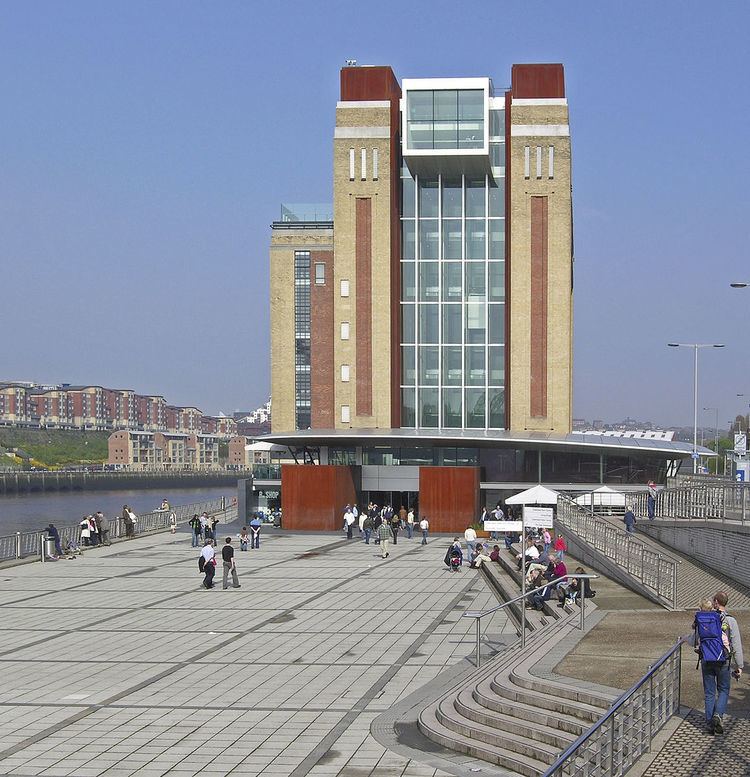 | ||
Baltic Centre for Contemporary Art (BALTIC) is an international centre for contemporary art located on the south bank of the River Tyne alongside the Gateshead Millennium Bridge in Gateshead, Tyne and Wear, in North East England, United Kingdom. It presents a constantly changing programme of exhibitions and events. It opened in 2002 in a converted flour mill. •Theories about the origins of the name of the mills include being named after the Baltic Exchange in London which was the hub of wheat trading for many years or after the fact some of the grain came from the Baltic area. •Most probably named after the Baltic Sea as other Rank Hovis Mills around the country - Ocean Mill, Solent Mill, Atlantic Mill - were named after seas or rivers. Rank's London HQ was called Baltic House. •The building still contains the grain hoppers which are individually numbered and run almost the whole height of the building. The Director is Sarah Munro who joined Baltic in November 2015. Munro is the first woman to hold the position of Director in the history of the Baltic Centre for Contemporary Art. BALTIC is a registered charity under English law.
Contents
Reception
The founding director, Sune Nordgren was appointed in 1997 and was integral in BALTIC's pre-launch period, having overseen the building of the gallery and witnessed the first one million visitors through the doors. After almost six years, Nordgren left to take up a new post as founding Director of the National Museum for Art, Architecture and Design, Oslo, Norway. He was briefly succeeded by Stephen Snoddy who was only with the organisation for one year. Snoddy was succeeded as Director by Peter Doroshenko in 2005, who approached the challenge with plans to increase visitor numbers and resolve the financial situation. Doroshenko organized several exhibitions during his time at the BALTIC, including Spank the Monkey. In November 2007, Doroshenko left the gallery to head up the Pinchuk Art Centre in Kiev, Ukraine. Since 2008, the director has been Godfrey Worsdale, founding director of the Middlesbrough Institute of Modern Art.
On 20 September 2007, BALTIC management contacted Northumbria Police for advice regarding whether or not a photograph should be displayed as part of the Thanksgiving installation, a forthcoming exhibition by American photographer Nan Goldin. The photograph entitled Klara and Edda belly-dancing (which, along with the rest of the installation, is part of the Sir Elton John Photography Collection) features two naked young girls and had previously been exhibited around the world without objections. The installation, which had been scheduled for a four-month exhibition, opened with the remaining photographs but closed after just nine days at the request of the owner.
In 2011, BALTIC was the venue for the Turner Prize, this was the first time the event has been held outside of a London or Liverpool Tate in its 25 years. The Turner Prize exhibition at BALTIC attracted over 149,000 visitors, more than at any previous Turner Prize exhibition.
Building
The Baltic Flour Mill was built by the Rank Hovis company to a late-1930s design by architects Gelder and Kitchen and completed in 1950. It was extended in 1957 by the addition of an animal feed mill. The mill was closed in 1981. It was one of a number of mills located along the banks of the Tyne, all of which, due to their size, were prominent local landmarks. As of October 2011, the Spillers mill just downstream from the Baltic on the north bank of the river is in the process of being demolished. Another large mill was owned by the CWS and was located just upstream of Dunston Staithes. The site of this mill and the adjacent CWS soap works is now occupied by a housing estate.
Dominic Williams of Ellis Williams Architects won an architectural design competition, managed by RIBA Competitions, in the mid-1990s to convert the 1950s Baltic Flour Mill into a centre for art. After ten years in the planning and a capital investment of £50m, including £33.4m from the Arts Council Lottery Fund, BALTIC opened to the public at midnight on Saturday 13 July 2002. The inaugural exhibition, B.OPEN, featured work by Chris Burden, Carsten Holler, Julian Opie, Jaume Plensa and Jane & Louise Wilson and attracted over 35,000 visitors in the first week.
